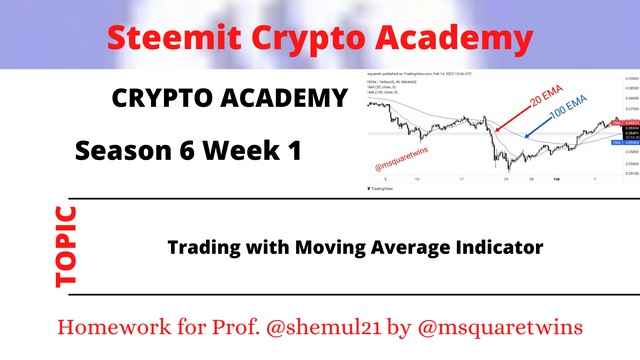

Introduction

Hello crypto Lovers,
It is another great opportunity again to participate in the crypto academy task. We are already in week 2 in season 6. I hope you enjoyed the first week. I am Kehinde Micheal and my username is @msquaretwims here on this great platform. In this task, I will be answering the questions posted by professor @shemul21 in the homework task. Please follow me closely as answer the questions based on my own understanding of the topic. Happy reading!

1. Explain Your Understanding of Moving Average.

Moving average is one of the indicators that is mostly used by traders to analyse financial market. It is a technical indicator that is used to do technical analysis on chart. In financial market, price can move in an upward direction, downward direction or even sideway. Moving average indicator is employed on chart to identify the direction of an asset.
It is a moving line which moves along with the price on the main chart. In financial trading, technical analysis is one of the great analysis that is used to predict the price behaviour and moving average indicators among many plays a very essential part in the prediction of market price and direction.
Apart from the ability of moving average to determine the trend of an asset, it is also used to identify the support and resistance level of an asset at a particular period of time. Not only that, it is also greatly used to identify point of reversal. More so, traders also use moving average indicator as a signal to enter and exist a trade order.
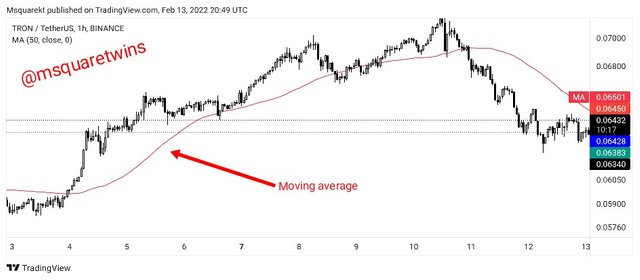
Moving average helps traders to know what other traders are doing in market. For instance, when price is trading above moving average, it means more buyers are participating in market than sellers at a particular time, and the trend at that time is said to be bullish. The otherwise is the case if the price of an asset is trading below the moving average. Price below the moving average means that there are more sellers in market than buyers and this means that the trend is to the downside at that time.

2. What Are The Different Types of Moving Average? Differentiate Between Them.

In this question, I will discuss the types of moving average that are employed in chart to detect the directional movement of an asset. The different types of moving average are;
• Simple Moving Average (SMA)
• Exponential Moving Average (EMA)
• Weighted Moving Average (WMA)
Now let's briefly talk about them.
Simple Moving Average (SMA)
Simple Moving Average as it name, is the simplest of all the moving averages employed on chart to determine the price direction of an asset. It calculates the average price of an asset. It shows the market data of an asset as a dynamic line on the main chart of an asset.
It works with all the prices available on the chart which helps traders and investors to know the average price of an asset at a particular period of time. The Simple moving average moves as price move and at the formation of a candle, it shift it position adjusts.
The formula for calculating the simple moving average is displayed in the picture uploaded below.

Exponential Moving Average
Exponential Moving Average (EMA) is another powerful moving average that is also used by many traders for technical analysis. Just like simple moving average, exponential moving average also track the trend direction of an asset. The only difference between the two is while moving average use simple calculation to determine the average price of an asset in tracking direction, exponential moving average makes use of complex calculation to determine the most recent changes in price of an asset.
To that effect, there is accuracy and effectiveness of prediction of price movement with the use of exponential moving average. Also, because of the ability of exponential moving average to predict the recent change in price and trend reversal, it is greatly used for short term trade. Although many traders combine exponential moving average and simple moving average together to get better result of their analysis.
The formula for calculating the exponential moving average is displayed below.
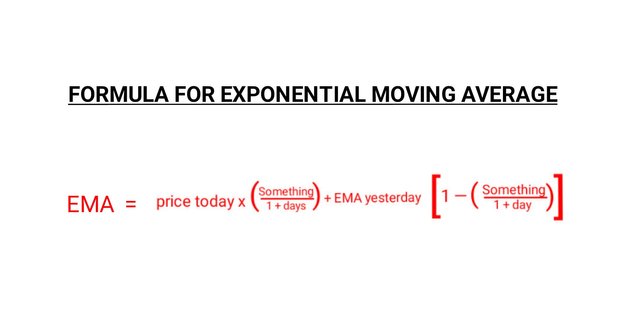
Weighted Moving Average
The weighted moving average is the last type of moving average which is also use to determine the trend direction of an asset. It uses statistical method of calculation which gives greater weight to the most latest price of an asset. Unlike simple moving average, weighted moving average gives less consideration to the past market price or data.
The most recent or latest data is greatly employed in this type of moving average.
The formula for calculating weighted moving average is uploaded below in a screenshot.
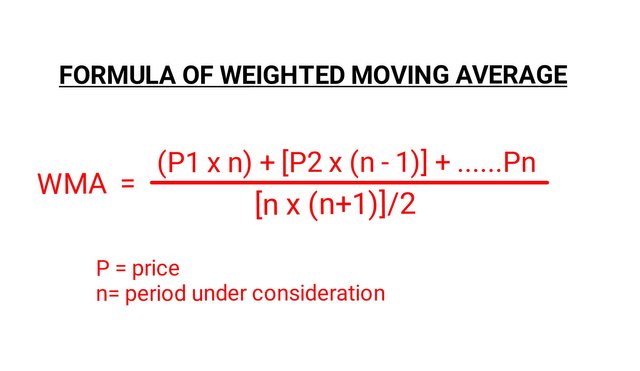
Comparison of Different Types of Moving Averages
| SMA | EMA | WMA |
|---|---|---|
| The average price over a period of time is taken into consideration | EMA do it calculation by using today's value of price | It uses the most recent price. |
| It shows average value of an asset over a period of time | The recent value is taken into consideration by EMA | Emphasises is on reducing recent data and uses very latest data. |
| It is employed for long term trade | It is suitable for short term trade | It is used for very short time trade and long term trade. |
| It reliability is based on long time or higher time value. | It accuracy is based on the short time frame of lower value | It is accurate for both long and short term trade. |

3. Identify Entry and Exit Points Using Moving Average. (Demonstrate with Screenshots)

Moving averages are a powerful indicator that can be used to identify entry and exit point in market. The moving averages can be combined in market to make good market decision. For example, we can combine simple moving average, exponential moving average and and weighted moving average together in a single chart.
In the chart uploaded below, three moving averages are added to chart as seen in the image below.
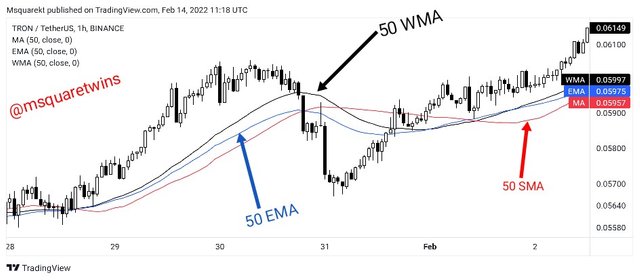
We can see that the 50 WMA is very close to the price than 50 EMA and 50EMA is close to price than SMA.
Also, let's add another moving averages to the chart to check the chart reading and to determine possible entry and exist point in market using these moving averages. Let's add 100 Simple moving average and 20 exponential moving average to the chart. The moving average in this case act as a dynamic support and resistance level. We open a buy or sell order if price get close to these moving averages.
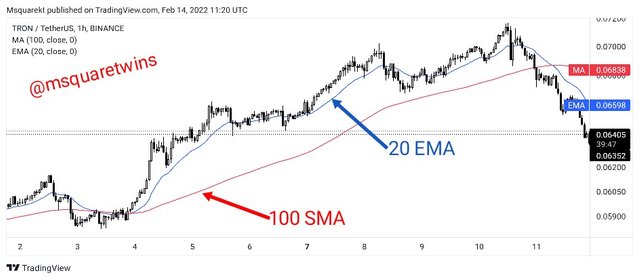
We can see from the image uploaded above that price is trading in an uptrend as price was trading above 100 SMA. This means that buyers are more in market at that particular period of time. We can also see that at any retracement of price to the 20 EMA, it keeps pushing the price upward.
Now let's see how we can demonstrate entry using moving average from a screenshots below.
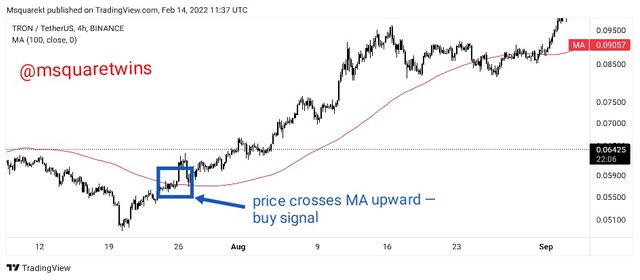
From the image uploaded above, we can see that price was previously in a downtrend creating lower highs and lower lows. Buy at some point, price changed direction and moved above the moving average as indicated by a box and a arrow in the screenshot. At this point, this means that buyers has taken control of the market from the sellers. And as we can see, the asset trader to the upside. So, a buy opportunity presented itself immediately price moved above the moving average.
The bullish candle that closes above the moving average line pushed the market upward. This point is therefore a great area to enter a buy order. The exist of this order should be taken immediately price approaches the moving average indicator to the downside.
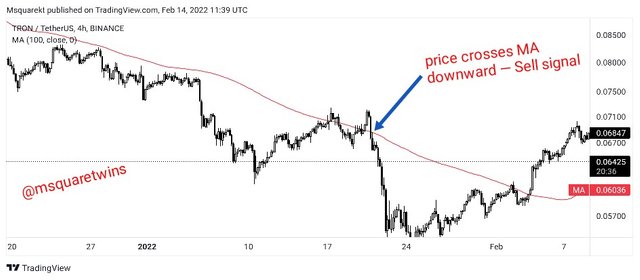
Also in the picture uploaded above, we have a good point fora sell entry market. Notice that at a pont indicated by a blue arrow in the screenshot, price approaches a moving average from up and this made a bearish candle to close below the moving average. This is a good point for entry position for a sell order. This bearish candles causes the market to move greatly to the downside as seen in the picture. An exit order should be taken at the approach of price from bearish direction to the upward direction.

4. What do you understand by Crossover? Explain in Your Own Words.

The Moving average crossover is a technique used to effectively analyse an asset especially to get a trade signal. It is a combination of two moving average to get desired result. Traders combine two moving averages together and wait for crossover of these moving averages on chart to take trade decision. When the moving averages cross each other from down-up, traders take a buy position. When this happen from upside down, a sell position is always envisaged.
The combination of moving averages to get crossover can be the combination of the the same moving average or different types. For instance, two simple moving average can be combined on chart to get crossover, or one simple moving average and one exponential moving average.
An example of this is the combination of 100 Simple moving average and 20 exponential moving average. The shorter moving average, i.e the 20 EMA is the faster moving average because it moves very quick. while the 100 SMA , slower moving average is the longer moving average because it moves very slow on chart. It should be noted that the smaller moving average in this case requires very small amount of data and that is the reason why it tends to move quickly as price moves. But the longer moving average needs more data for the calculation of average price and as such, it tends to move behind the price.
The screenshot uploaded below shows the two moving averages added to chart and how they lie to the price of an asset on chart.
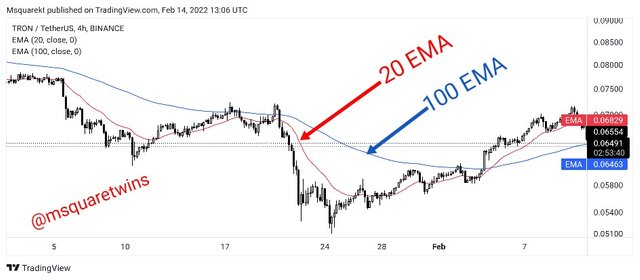
We can see from the above chart that 20 EMA lies very close to the price than 100 EMA because it requires little data and as such gives quick reaction.
The purpose of crossover is to narrow an entry or exist point in market and traders use the crossover signal to take entry and exist an order in market. The following rules are taken into account for crossover signal
• Buy position is taken or hold when the faster moving average exceed the slower moving average.
• When the short term or the faster moving average goes below the slower moving average, exist is made in the market.
Let's see an example of a sell signal using a crossover strategy of moving average.
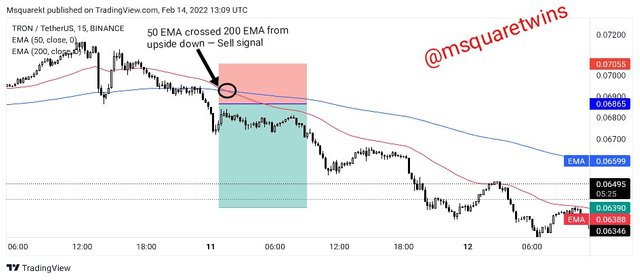
As seen from the picture uploaded above, the 50 EMA crossed the 200 EMA from upside down and that shows that sellers have taken over the market. Price then traded to the downside.

5. Explain The Limitations of Moving Average.

In the questions above, I have clearly explained the importance of moving averages especially in the identification of trend, in spotting resistance and support level as well as in the identification of good point for entry and exist order. However, there are some limitations to the use of moving averages.
Some of these limitation are explained below;
• Moving average is a lagging indicator. Moving average indicator lags behind the price of an asset and as such, traders finds it difficult to know the exact point to enter a position in market because price moves ahead of moving average indicator.
• Moving average does not take into account the market data out the average period and that is a great drawback.
• There is no rules or guideline to use to determine the exact time period for different time period that a trader might want to consider when trading. Therefore, cautions should be taken when using moving average for different time period.
• Moving average disregards many time series by calculating the average price and this makes long term of trend series to be uncovered.
• The moving average continuously gives new data of average value of an asset and as such the forecast value also changed.
• If a trader use unadjusted moving average, it may lead to the failure of the predicted move.

Conclusion

Moving average is a great technical tools that is greatly employed by traders to do technical analysis. It is useful in the prediction of market direction, identification of support and resistance level as well as entry and exist point in market. More so, moving average helps a trader to know what other traders are doing in market based on the price behaviour in line with moving average at a particular period.
In this task, I have explained the usefulness of moving average indicator and different types of moving averages that used for technical analysis. I also identified entry and exit point using moving average. Lastly, I explained cross over strategy of moving average indicator and the limitation of moving average indicator.
Special thanks to professor @shemul21 for this great lecture.
Thank you for reading.